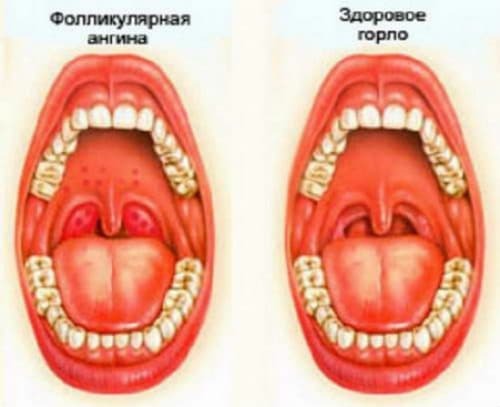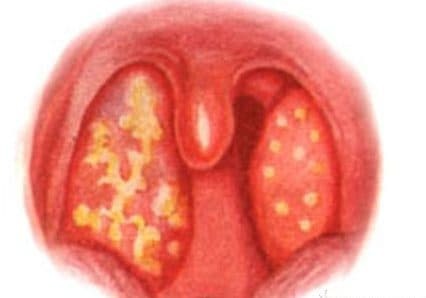
Acute tonsillitis is a disease that is today one of the most common. Angina acute form may have a viral, bacterial or fungal nature. In addition, it is classified according to the symptoms. Treatment should occur immediately after the discovery of the first symptoms. If this is not done, chronization of the inflammation and the occurrence of a number of complications is not ruled out.
Contents
- 1 Reasons
- 2 Symptoms
- 2.1 Catarrhal
- 2.2 Lacunar and follicular
- 2.3 Necrotic
- 3 Complications of
Causes of
Bacteria, viruses and fungi can affect the development of acute sore throat. In most cases, the development of the disease is associated with the defeat of staphylococcus. For the formation of acute tonsillitis, it is important to observe two conditions: prolonged exposure to cold and penetration of pathogenic microorganisms in large quantities.
Is it contagious? Mass damage by bacteria can be seen by contact with the patient.
A distinctive feature of bacteria is that they can not spread over long distances, which can not be said about viruses. Therefore, there is absolutely no way to catch the ailment in the store, public places and transport. A prerequisite for infection will be direct contact.Most often acute tonsillitis can affect people who are inside the family, because the infection will be transmitted through kisses, common household items, kitchen utensils. The reason for infection of the child is in the toy, which he can get from a person who has tonsillitis.
On video symptoms of acute tonsillitis:
The development of acute tonsillitis can be associated with local local hypothermia. Very often streptococcus is on the tonsils of healthy people and does not make itself felt. A similar phenomenon can occur with increased immunity when its strength and strength are equal. In medical terminology, this process was termed tonsillitis in subclinical form.
With strong local overcooling, the body's defenses decrease. This can be observed when consuming cold drinks and foods. Disease in young patients is due to eating snow and licking icicles. As a result, streptococci, which was inactive, begins to multiply and makes itself felt. Thus, there is a pronounced clinical picture of acute tonsillitis.
 How the paratonsillar abscess of the throat looks, and what medicines should be used in this case, is very detailed in this article.
How the paratonsillar abscess of the throat looks, and what medicines should be used in this case, is very detailed in this article.
And here's how the symptoms of paratonsillar abscess look, you can see in the photo in this article.
It will also be interesting to know how the parathonsillar abscess is opened: http: //prolor.ru/g/ bolezni-g /abscess/ paratonzillyarnyj-vskrytie.html
It will also be interesting to see what a paratonsillar abscess looks like in a child.
Symptoms
The incubation period of acute course is 12 hours - 2-3 days. First, the temperature rises, chills, painful sensations in the throat. In addition, when probing, you can see how the lymph nodes are enlarged. All other symptoms of acute tonsillitis depend on the form of the disease.
Catarrhal
For this ailment is characterized by superficial damage to the tonsils. The patient has mild symptoms of poisoning. Temperature indicators do not increase significantly. When the blood test is taken, no changes will be detected.

On the photo-acute catarrhal tonsillitis
During pharyngoscopy, you can identify a bright reddening of the tonsils, which extends to the back wall of the pharynx. The tonsils themselves increase in size, but this is achieved due to swelling and redness. The catarrhal form lasts about 1-2 days, and then the inflammation subsides or another form of angina is formed.
Lacunar and follicular
These forms of ailment have a vivid clinical picture. The temperature of the bodies rises to 39-40 degrees. Observed symptoms of poisoning: weakness, pain in the head, pain in the heart, muscles and joints. A general blood test shows leukocytosis with a neutrophil shift to the left. When you pass urine analysis you can see traces of protein and red blood cells.

On the photo-acute follicular tonsillitis
If we talk separately about lacunar angina, then it is typical for the defeat of the tonsils in the zone of lacunae. The purulent deposit affects the untouched surface of the palatine tonsils. During the examination, the doctor discovers redness, swelling and an increase in tonsils and lacunae. For lacunar angina characterized by loose plaque, which has small foci. He does not leave the border of the tonsils, it is easy to remove without the presence of bleeding wounds.
But the follicular form is accompanied by damage to the follicular apparatus of the tonsils. Upon examination, the doctor diagnoses redness of the tonsils, swelling, and through the epithelial tissue follicles are visible. They have the form of a whitish-yellowish formation. Their size corresponds to the head of the pin. Purulent follicles can be opened, forming a plaque that does not go beyond the tonsils.
Necrotic
This form of tonsillitis is characterized by a more pronounced clinical picture. There is a persistent fever, vomiting, which is repeated from time to time, confused consciousness.

On photo-acute necrotic tonsillitis
Upon examination, the physician can observe the following manifestations of sore throat:
- Tonsils affected by the inflammatory process are covered with a plaque that has an uneven, friable and dull surface with a greenish color.
- Affected areas are impregnated with fibrin, as a result of which they acquire a density. When they are removed, a bleeding wound occurs.
- After the necrotic areas have come off, a profound tissue defect arises. Its size is 1-2 cm, and the shape is often irregular, having an uneven and hilly bottom.
- Necrosis can extend beyond the borders of the tonsils, affecting the arch, tongue and back of the pharynx.
And here is how the vacuum cleansing of the tonsils under tonsillitis occurs, and how safe it is for the body and for health will help to understand this article.
It will also be interesting to know whether it is possible to cure chronic tonsillitis, and what medicines are best.
How is tonsillitis treated during pregnancy, and whether it is possible to use medicines, will help to understand this information.
You may also be interested in knowing which tonsillitis medications should be used first, is described in great detail in this article.
But what is viral tonsillitis and how it is treated is described in detail in this article.
Complications of
If you do not start timely therapy, then it is possible that acute tonsillitis will acquire a chronic form, which will lead to serious complications. There are early and late complications of angina.
The occurrence of early effects is observed during the period of the disease and is associated with the spread of the inflammatory process to nearby organs and tissues.
To early complications include:
- peritonzillitis, ulcer formation,
- lymphadenitis of regional lymph nodes,
- chronic runny nose,
- tonsillogenic mediastinitis.
On video complications of acute tonsillitis:
But late effects occur in 3-4 weeks. They are of an infectious and allergic origin.
The late consequences include:
- joint damage,
- post-streptococcal glomerulonephritis.
Tonsillitis in acute form has a pronounced clinical picture. Depending on the variety of the disease, these or other symptoms are distinguished. Treatment can begin only after an accurate definition of the pathogen and type of angina. Otherwise, the therapy will be appointed incorrectly, which will contribute to the development of a number of complications.
